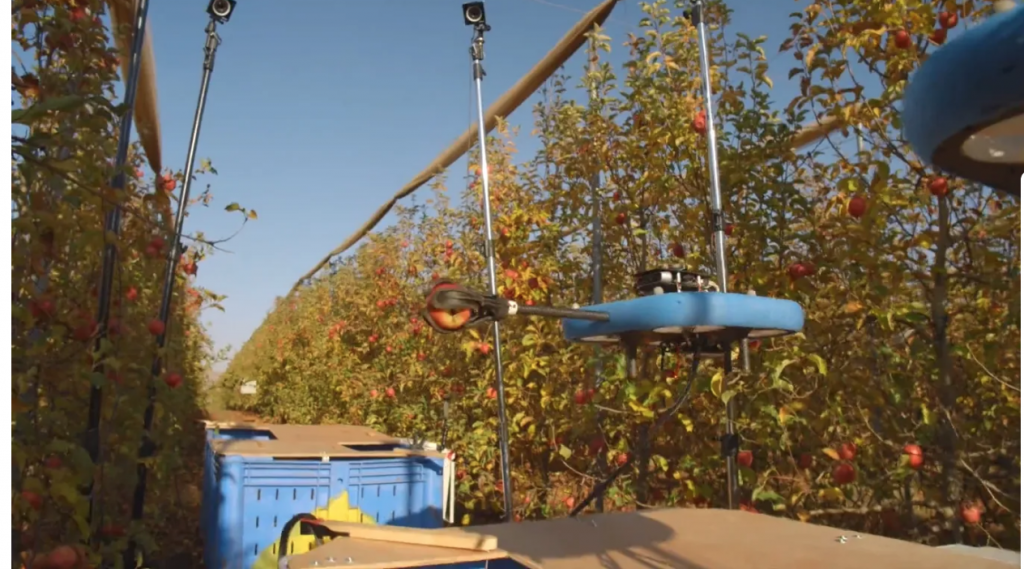
These Israeli AI drones by Tevel Aeribotics Technologies, are used to pick fruit.
Array of Robots Ease Life for Doctors, Consumers with Fruit Picking, AV Communication
Seeflection.com decided to take a look at robots this week, and instead of several different stories about different bots we thought we would roll them all into one for a super robot overview.
First up, the possibility that your vacuum cleaner is feeding your information to others is under scrutiny. Stuff like the square footage of your living room, or maybe even deeper pieces of information, like hacking electronics in the house are all cause for concern. Consumerreports.com reported on which robot vacuums might be hacking into your life.
Most robotic vacuums use mechanical sensors, optical sensors and advanced software to clean floors. And most connect to the internet, which puts them in the same category as video doorbells and webcams, which collect personal and environmental data to serve the user better.
As part of Consumer Reports’ Digital Lab recently tested robotic vacuums and found that on the whole, their potential vulnerabilities aren’t as worrisome as those for video doorbells, but that manufacturers could still adopt more robust security measures. After all, in some cases, it’s a bot with a camera connected to the internet scooting around your house. Spooky stuff.
Click this link to see the rest of the story.
AI Bearing Fruit
Tevel Aerobotics Technologies, which develops flying fruit-picking robots that provide autonomous on-demand harvest, announced this week it has raised $20 million for its technology. Investors in this round include venture capital firms Maverick Ventures Israel, OurCrowd, AgFunder, as well as Asian agriculture equipment producers Kubota and Forbon. This brings the company’s total funding to $33.9 million, which includes a $2.5 million grant from the Israel Innovation Authority, according to AgFunder News.
Tevel, based in Tel-Aviv, has developed a patented platform called FAR (Flying Autonomous Robots) that is a combination of the actual flying robots, algorithms, AI and data analytics. The flying robots are equipped with computer vision and AI that detects fruit and foliage and identifies the type of fruit, size and ripeness. Attached to the drone is a three-foot-long claw for grabbing and picking the fruit. Additionally, the small drones are capable of other tasks like pruning, trimming and thinning orchard trees.
Fruit picking is dependent on available labor, which has been consistently declining throughout the world in the past few years, causing labor shortages in orchards. Even though agriculture workers are considered essential personnel, the pandemic has caused delays for laborers seeking visas to pick fruit in other countries.
Tevel isn’t the only company looking into this market. Root AI raised $7.2 million last summer for its tomato and strawberry harvesting robots. Companies such as Greenfield Robotics, Small Robot Company and FarmWise use AI-powered robots to remove weeds from crop fields.
Read more about AI drones here.
Hospital & Surveillance Robots
BR Ambedkar National Institute of Technology, Jalandhar has developed a multi-purpose service robot ‘Cutebot.’ It can be used in a hospital environment as well as by security agencies for surveillance.
The robot is enabled with a wheeled mobile platform. Doctors and medical staff can interact with patients of Covid-19 and other infectious diseases through the audio-visual screen of the robot while sitting in their rooms through its camera and voice communication system, an official statement said.
Cutebots can help in guiding patients on medicines and also deliver refreshments in the isolation wards. For security personnel, it can help in surveillance and in some other required areas, it said. The robot has been designed jointly by Kuldeep Singh Nagla, Associate Professor and a specialist in robotics and automation and Professor L K Awasthi, director of the institute.
The robot was announced by the Chairperson of the Board of Governors of NIT Jalandhar, Subhash Chandra Ralhan. It can carry around a 15-kilogram weight in the hospital environment, besides doing other jobs. With the virus hitting India at about the same rate as here in the U.S., it won’t be long before more jobs will have to be done by robots.
read more about cutebots here.







Leave A Comment